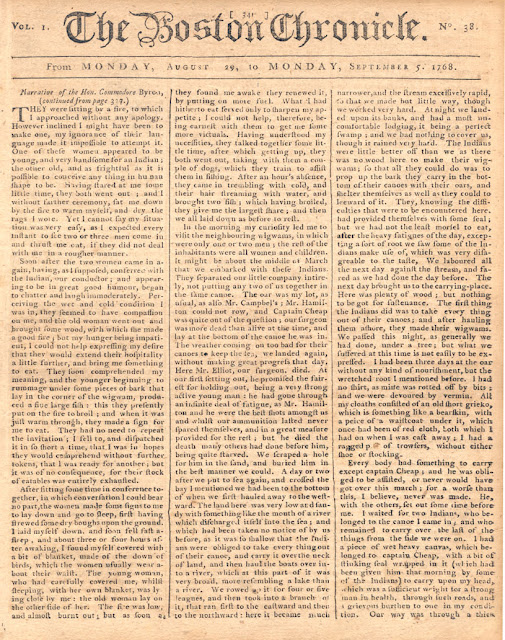The partnership lasted only a few months before it was dissolved. Before the arrival of Mein, the leading bookshop in Boston had been "The London Bookstore", owned by Messrs Rivington and Miller and located in King Street. Mr Miller had been ill ( he died in November 1765) and, in the autumn of 1765, Mein was able to take over the shop, newly redecorated and enlarged by the former owners. He then established a lending library, the first one of its kind in Boston, where patrons could, for a fee, borrow books from a 1200 book library. (Only one book could be charged at a time.) Mein had connections with a bookseller in Scotland who provided him with the latest editions, in English, of the most saleable books. Among his patrons was John Adams. Given his education, interests, and intellect, one could assume that Dr Church was also one of the Library's patrons.
Mein then decided that he would expand into the printing business. Mein had been using the firm of McAlpine and Fleeming to print his books. He had labeled himself a "printer" but he was, in modern terms, a publisher and had been using McAlpine and Fleeming to print his books. John Fleeming, a fellow Scot and the future brother-in-law of Dr Church, had arrived in Boston three months prior to Mein also aboard a ship from Glasgow. Fleeming left McAlpine and formed a partnership with Mein (Mein and Fleeming). Fleeming then returned to Scotland where he procured a press, printing materials, and hired three or four journeymen printers. Fleeming returned to Boston on the last day of October, 1766, and the partners opened a printing business in a house in Wing's Lane. Further expansion came in 1767 when the firm moved to Newbury Street . The printing shop, where some books might also be bought, was on the ground floor and Mein, Fleeming and some of their employees had quarters on the floor above. A March 1770 inventory of the establishment taken in connection with a lawsuit against Mein gives a glimpse into the shop:
"Seven Frames on which are Sixty Five Cases with the Types, etc.
Two Printing Presses with all the Materials Thereto
One large Iron Stove
One composing Stone, two cutting presses, one grind Stone
Two Stoles [stalls?] with a number of small articles in Said Room"
 |
| Printing Press of Isiah Thomas, Publisher of Massachusetts Spy, rival of the Boston Chronicle |
Within four years, John Mein, along with his partner John Fleeming, had established himself as the outstanding American publisher of the day both in the number and quality of the books he published.
Mein and Fleming further expanded their business when, on the 21st of December 1767, they started publication of the The Boston Chronicle. John Mein was the publisher of the Chronicle which was printed by Fleeming, on a whole sheet, in quarto, on a new and handsome type and, in mechanical execution, far surpassed any newspaper that had appeared before it in New England. The price was very low, six shillings and eight pence a year, for a paper containing such an amount of news and articles. The paper had few advertisements and it contents consisted chiefly of articles from the foreign press and from the works of popular English authors, including numerous extracts from the writings of John Wilkes and the celebrated "Farmer's Letters" of Pennsylvania. It was designed to emulate "The London Chronicle." For the first year, it was published weekly, on Mondays. It grew daily in reputation and had a very handsome list of subscribers. At the beginning of the second year, the size of the paper was altered to the size of a crown folio (15" x 10" in size) and published every Monday and Thursday with no increase in price, thus becoming the first newspaper to be published twice a week in New England.
Before the end of the second year of publication of the Chronicle, however, John Mein, a Scot with a fiery temperament, was engaged in a fierce war with the Whigs who were opposed to the British Government's tax laws and Mein inserted himself right in the middle of the struggle over the Non-Importation agreements.
The story of the volatile John Mein and his fight with the Whigs will be told in Part II of John Mein.



Once again, Mr Witek has introduced another brief history lesson into the life and times of Benjamin Church.
ReplyDelete